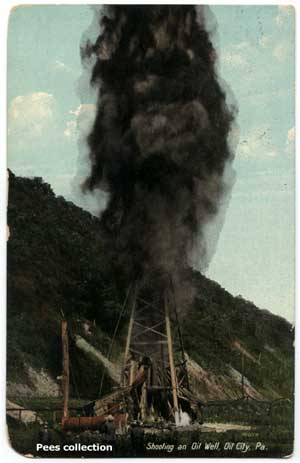 |
||||||
Nitroglycerin
Invented in 1846, this liquid which looked like oily lard was to eventually find great use in well completion practices and to render havoc and death to the unwary as well as to the careful shooter who thought his precautions would see him safely through the day.
At first the liquid was assumed to be benign by its Italian inventor, Ascanio Sobrero, but the chemical soon announced itself by blowing up the laboratory. It consisted of nitric acid, sulfuric acid and sweet-smelling glycerin. What possessed the chemist to mix these ingredients? It was an experiment in science and the product was misunderstood by quite a few people who unluckily had some around. After all, there wasn’t a book or pamphlet on the subject. Among the tales: deaths occurred from drinking this poison (it tasted like whisky), it was used in lamps due to its oily appearance (burned OK), it was mistaken for real lard and used in cooking (ugh!), was prescribed as a heart stimulant, sat in forgotten dust-covered bottles on chemists and pharmacies’ shelves, and so on. It was learned that it could be used as an explosive in mining, quarries and tunneling. It eventually earned fear and respect and there wasn’t any arguing with it. When it went off, the result was carnage and the newspapers would print the usual headlines.
Roberts learned of this compound and found that it performed much better than gunpowder in smashing the rock and cleaning paraffin out of the wells. He subsequently built a factory at what he determined was a safe distance from Titusville and manufactured nitroglycerin for his company’s use and for licensed parties.
The water tamp or wad still played an important role when nitroglycerin was used in that for at least the first split second it diverted part of the mighty explosion sideways into the formation before forcing the water, oil rocks and debris from the device up the hole at a mad rate. The column usually crested considerably above the derrick and then rained its load over the well site. Afterwards the rig hands slowly returned to the scene and cleaned up the mess as best they could.
The quantity of nitroglycerin used for a single shot was 4 to 6 quarts at first. It was increased in time to 60, 100 and 200 quarts, necessitating ever longer shells (torpedoes) or a series of shells.
 |
Effects of a nitroglycerin shot in well with standard derrick near Oil City, early 1900’s. From a postcard. Pees collection. |
![]()
| © 2004, Samuel T. Pees all rights reserved |
|